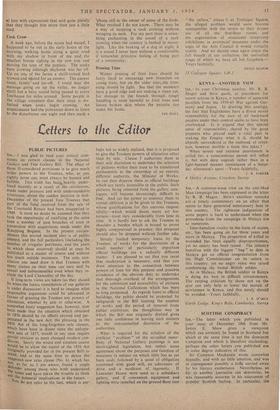&tiers to the editor
PUBLIC PICTURES
111,-1 was glad to read your critical conv- ents on certain clauses in the National Gallery and Tate Gallery Bill. The effect of these ill-considered provisions is to give much wider powers to the Trustees, who, as you rightly point out, must always be human and fallible. This truth has been, heavily under- lined recently as a result of the revelations, made under pressure and with understandable- reluctance, about the sudden decision in mid- December of the present Tate Trustees that part of the fund received from the sale of the Courtauld Renoir had been misapplied in 1949. It must no doubt be assumed that they took the opportunity of rectifying at the same time a number of past breaches of trust in connection with acquisitions made under the Knapping Bequest. In the present circum- stances this second incident also is of public interest, and the full particulars (including the number of irregular purchases, and the years in which these occurred) should at once be published as a matter of course and without too much outside insistence. The only con- clusion one need draw is that Trustees with many claims on their time can very well be casual and unbusinesslike even when they in- clude the Lord Chancellor of the day. If long-term views are taken (as they should be when-the future constitution of our galleries is under discussion) it is hard to imagine what responsible arguments could be advanced in favour of granting the Trustees any powers of alienation, whether by sale or otherwise. A somewhat hasty suggestion has, however, now been made that the situation which obtained in 1856 should be (in effect) revived and per- petuated in the new Act; the phrasing in the 1856 Act of the long-forgotten,•sale clauses, which have been in disuse since the unfo(tu- nate sale of 1857, would in any case require Partial revision to meet changed modern con- ditions. Surely the wisest and simplest course would be to allow the repeal of the 1856 Act (originally provided for in the present Bill) to stand, and at the same time to delete the suggested new sales clause (No. 6), which has 11.°(, as far as I am aware, found a single tcefender among those who both understand the issues and have taken the trouble to think out x',the Potential implications in the future. do not refer to the fact, which is per- haps not so widely realised, that it is proposed to give the Trustees powers of alienation other than by sale. Clause 5 authorises them at their sole discretion to undertake the selection of pictures Within their trust to be transferred permanently to the ownership of an entirely different authority, the Minister of Works; he can then disperse them in official buildings which are rarely accessible to the public. Such pictures, being removed from the gallery cata- logues, will become increasingly difficult to find. And yet the power to sentence them to virtual oblivion is to be given to the Trustees, whose qualifications for this onerous respon- sibility—which would daunt many art his- torians—must vary considerably from time to time. It is hardly fair to ask the Trustees to shoulder a burden which is bound to prove highly controversial in practice; this proposal should also be dropped without further ado.
Strictly limited temporary loans by the Trustees of works for the decoration of a small number of particularly important official buildings are a radically different matter. I am pleased to see that you insist that moderation is necessary, and that yoU draw attention to the connection between powers of loan for this purpose and possible avoidance of the obvious duty to undertake that thorough overhaul of the arrangements for the exhibition and accessibility of pictures in the National Collections which has been so long postponed. As regards loans to official huildings, the public should be protected by safeguards in the Bill limiting the number 9f works and the period of removal from public exhibition; the thoughtless way in which the Bill was originally drafted gives one little confidence in leaving such matters to the untrammelled discretion of the authorities.
What is required for the solution of the artificial " problem " of the so-called super- fluity of National Gallery paintings is not short-sighted legislation, but rather some agreement about the purposes and function of museums (a subject on which little has as yet been said), followed by a sense of obligation combined with good will, an admixture of drive and a modicum of ingenuity. If Lancaster House were used as a subsidiary gallery, and if convenient equipment and lighting were installed on the ground floor (not " the cellars," please !) at Trafalgar Square, the alleged problem would soon become manageable; with the return to their proper use of all the first-floor rooms and the organisation of occasional temporary exhibitions in provincial museums under the aegis of the Arts Council it would virtually vanish. And we should once again enjoy the full benefit of our collection, the unrivalled range of which we have all but forgotten.— You rs faithfully, 33 Cadogan Square. S.W.1
DENIS MAHON










































 Previous page
Previous page